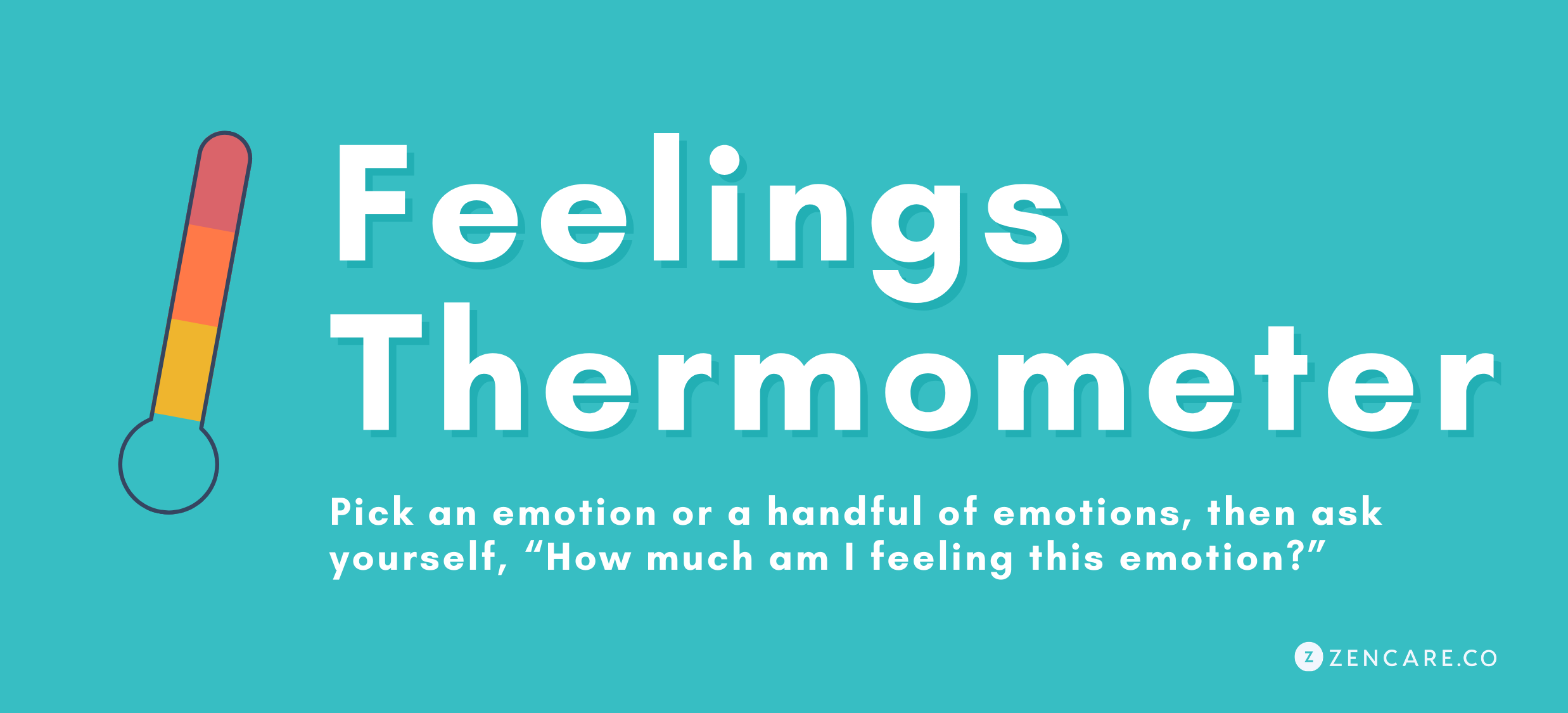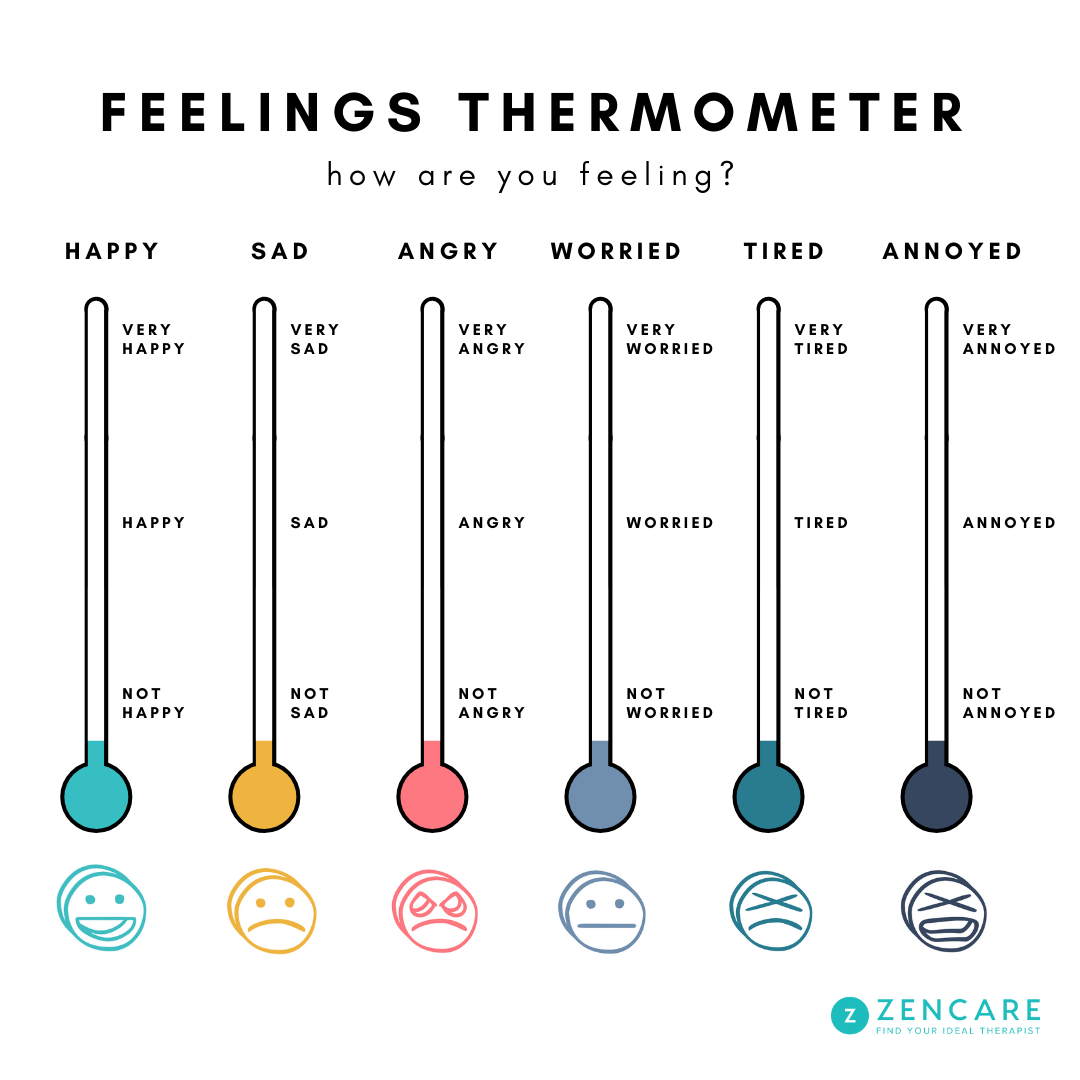“Good, bad, happy, sad.” There are many ways to answer the question, “How are you feeling?” Often, we use broad and nonspecific words to denote a positive or negative valence in our emotions. Sometimes, though, we’re given the chance to share more about our feelings.
A Feelings Thermometer is a great tool to use with children to help them visualize and share their internal emotional states. Having a physical representation available to them allows descriptions of their feelings, and practicing this over time develops their self-awareness, allowing them to also build up their coping skills.
As adults, we can break down an emotion into different parts or talk about how much of a feeling we have. Take happiness, for example – inside of happiness we might have joy, glee, thrill, excitement, gratitude, delight. Doing so gives a more colorful portrayal of our internal emotional state.
Now consider taking away the adult vocabulary we’ve developed. How do children describe how they feel? Words like “repugnant” and “sentimental” are not available to kiddos who haven’t yet learned them – haven’t learned the label, yes, but also haven’t yet learned these complex emotions. That's where the Feelings Thermometer comes handy.

What is a feelings thermometer?
In its most basic form, a Feelings Thermometer is a picture of a thermometer with various emotional states connected to its different sections. As the “temperature” rises, so do the emotions: Starting at the bottom, we might feel calm, happy, good. The middle part of the thermometer represents feeling just okay or a bit of discomfort. And when we reach the top of the thermometer, we feel angry, out of control, ready to explode. A Feelings Thermometer might utilize a red-yellow-green color scheme or assign numbers to the different sections to represent that intensity of the feelings.
There are many different forms of “thermometers” – some aren’t related to temperature at all, rather emotional “waves” or even charts with different facial expressions drawn out. Sometimes, a thermometer might represent just one isolated emotion and more attention given to the intensity.
However they’re drawn or used, though, these visualizations assist children describe how they’re feeling by giving them concrete ways to think about their emotions.
When is using a feelings thermometer helpful?
A Feelings Thermometer is helpful with young children – again, those that haven’t yet developed a robust vocabulary or haven’t yet reached a maturity level that yields self-awareness.
It is particularly helpful for times when a child is feeling something other than a positive emotion – though Feelings Thermometers can be adapted for any type of situation!
When using a Feelings Thermometer, children can not only identify their emotions via assessment of their internal state, but also show the intensity and full dimension of their emotions.
Using a visual that utilizes a range, a child can pinpoint exactly where they are on a spectrum, taking away a “black or white” response of simply “good” or “bad.” By encouraging children to use the visual tool, they learn that emotions are complex and wide-ranging.
As an example, a young boy might become upset because of something at school. When a trusted adult approaches the boy and asks what’s wrong, the boy simply says, “nothing.” Then when the trusted adult shows the boy a Feelings Thermometer and asks him to point to where he’s at – on a scale from happy and calm, to angry and explosive – the boy points to the upper third of the thermometer.
After additional questioning about why he pointed to that particular section, the boy says that his classmate laughed at him and it made him feel embarrassed and angry to a degree that he did not want to go back to school. In this example, the boy not only demonstrates that he’s upset, but he shows that he’s not at the very top of the thermometer – that he feels somewhat in control of his anger. The trusted adult might then ask what they could do to lower his “temperature.”
How to use a feelings thermometer
Here are a few tips for effectively using a Feelings Thermometer:
Pick one emotion for challenging times
While some versions of this tool show a range of emotions on one thermometer, if the child exhibits an emotion that may be complex in nature, making a thermometer out of one emotion (i.e. sad, frustrated) might be helpful in encouraging the child to go deeper into their explanation.
This gives you an idea on the intensity, which brings up probing questions such as, “Has there ever been another time you felt like a six on the thermometer?” or “So for sadness, you feel a three but for anger you feel a seven. Why is that?”
Identify different levels of feeling
By assigning numbers (or colors!) to the different sections of the thermometer, it becomes easier to talk about for children - having a concrete reference to return to and presenting a shared vocabulary.
Find other visualizations of emotions
This might include drawing out faces that show a range of emotions. Tell them that they can pick multiple faces, not just one! This shows them that emotions can be complex and a person isn’t limited to just one feeling.
Once you find a version you like, bring it with you
Create a portable version to bring with you and reference in all environments - school, out running errands, visiting friends or family members, anywhere! Make expressing emotions in a concrete way a habit for your kiddo!
When to seek professional support for helping your child through difficult emotions
The Feelings Thermometer is a great tool to help children identify not only what they’re feeling but the intensity of their emotion.
However, it might also be worthwhile to find the support of a child therapist if your child is having difficulty with their emotions or processing their feelings. Sometimes, children’s mental health looks quite different from adult mental health – for children, symptoms might include somatic complaints, inability to pay attention, or excessive crying or tantrums.
Therapists who work with children also use different techniques than therapists who work with adults. They may use more visual games (like the Feelings Thermometer!) or non-directive play therapy. If you think your child might benefit from more emotional tools like the Feelings Thermometer, Zencare will help you find a child therapist in your area.
Emotions are complicated; after all, sometimes even we adults have trouble describing how they’re feeling. By using a tool like the Feelings Thermometer, we can get a more dimensional answer from our little ones – and teach them that having diverse, wide-ranging emotions is not only normal but healthy, when given the proper attention!
